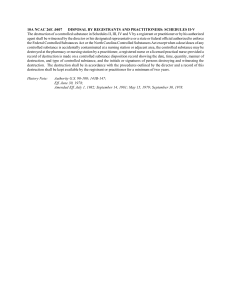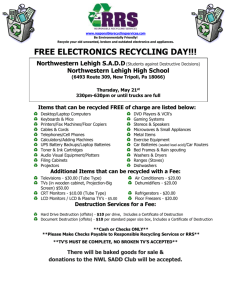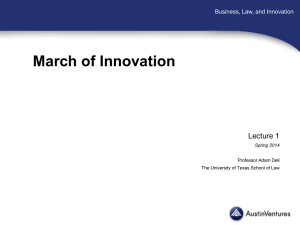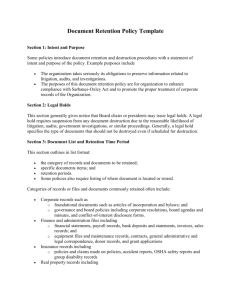E - Ozone Secretariat
advertisement
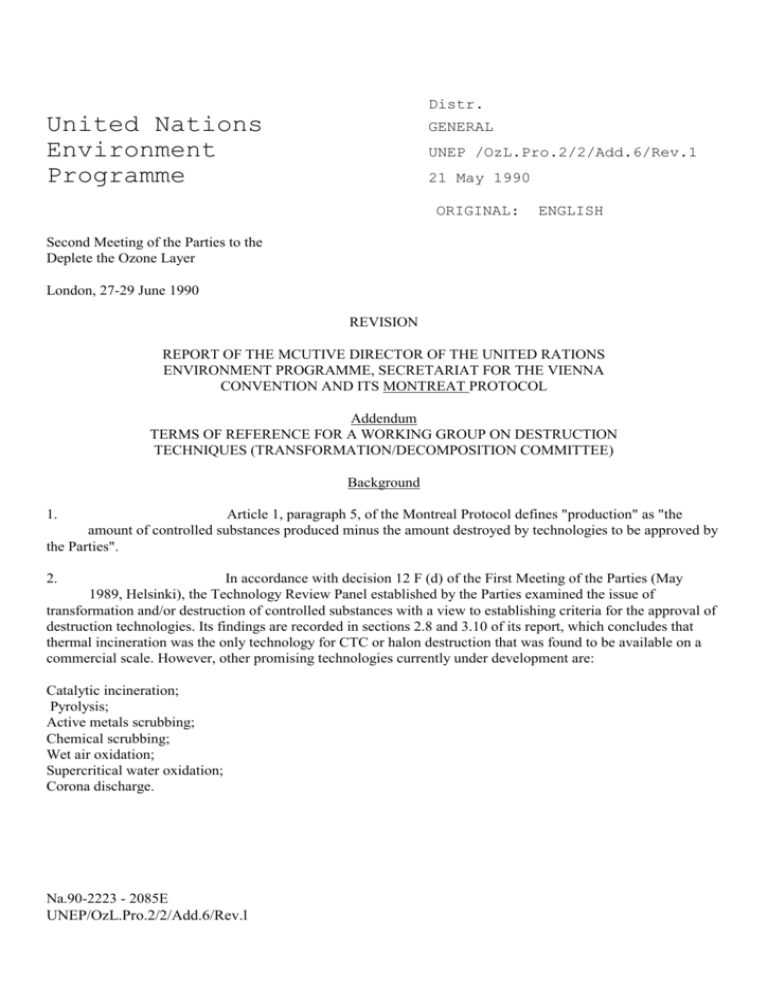
Distr. United Nations Environment Programme GENERAL UNEP /OzL.Pro.2/2/Add.6/Rev.1 21 May 1990 ORIGINAL: ENGLISH Second Meeting of the Parties to the Deplete the Ozone Layer London, 27-29 June 1990 REVISION REPORT OF THE MCUTIVE DIRECTOR OF THE UNITED RATIONS ENVIRONMENT PROGRAMME, SECRETARIAT FOR THE VIENNA CONVENTION AND ITS MONTREAT PROTOCOL Addendum TERMS OF REFERENCE FOR A WORKING GROUP ON DESTRUCTION TECHNIQUES (TRANSFORMATION/DECOMPOSITION COMMITTEE) Background 1. Article 1, paragraph 5, of the Montreal Protocol defines "production" as "the amount of controlled substances produced minus the amount destroyed by technologies to be approved by the Parties". 2. In accordance with decision 12 F (d) of the First Meeting of the Parties (May 1989, Helsinki), the Technology Review Panel established by the Parties examined the issue of transformation and/or destruction of controlled substances with a view to establishing criteria for the approval of destruction technologies. Its findings are recorded in sections 2.8 and 3.10 of its report, which concludes that thermal incineration was the only technology for CTC or halon destruction that was found to be available on a commercial scale. However, other promising technologies currently under development are: Catalytic incineration; Pyrolysis; Active metals scrubbing; Chemical scrubbing; Wet air oxidation; Supercritical water oxidation; Corona discharge. Na.90-2223 - 2085E UNEP/OzL.Pro.2/2/Add.6/Rev.l Page 2 3. A common measure of the performance of a chemical destruction technology is its destruction/transformation and removal efficiency. Although there are limited amounts of actual test destruction data on CFCs (CFC-11 and 12), the available data show high thermal destruction efficiencies (99.9998 per cent). Since these are two of the most stable CFCs it is anticipated that other CFCs (like CFC-113) would have similar, or possibly slightly better, thermal destruction efficiencies. 4. Environmental concerns surrounding CFC and halon thermal destruction (incineration) include the possible formation of potentially hazardous products of incomplete destruction and acid and/or halogenated gas emissions. Thermal destruction also produces acid gases (hydrogenchloride (HC1), hydrogen fluoride (HF), or hydrogen bromide (HBO and/or free halogen gases (chlorine(C12), fluorine (F2), or bromine (Br2)) when the halogen-containing parent compound is broken down in the incinerator. Removal of the acid gases requires scrubbing with either a water or caustic solution to react with the acid/halogen gases. Both water and caustic scrubbers are used for cleaning CFC destruction flue gases. 5. In addition to products of incomplete combustion and the formation of acid gases, incineration of CFCs will also produce combustion products such as C02, No. and Co. These combustion products include greenhouse gases. However, the amounts that are emitted are very small in comparison with other industrial emissions. 6. In conclusion, several promising technologies exist for destroying both CFCs and halons. However, only thermal destruction is currently at a stage where approval criteria could be established based upon information available in the literature. However, since conditions can vary widely with respect to destruction/transformation techniques and even thermal destruction conditions (including the possibility of many different co-fired wastes), establishing criteria for approving destruction techniques will require detailed consideration on a "per technique and per incident" basis. This may beat be achieved by a dedicated Working Group of the Parties calling upon specialists or consultants as required to provide the necessary technical expertise on any new or emerging destruction/transformation technologies. 7. Proposed draft terms of reference for such a Working Group are contained in the annex to the present document. / ... UNEP/OzL.Pro.2/2/Add.6/Rev.1 Annex Page 3 Annex PROPOSED DRAFT TERMS OF REFEUNCE FOR A WORKING GROUP ON DESTRUCTION TECHNIQUES 1. Purpose The purpose of the Working Group shall be to prepare recommendations to the Parties on the approval of proposed destruction techniques for controlled substances. 2. Composition of the Working Group The Working Group should consist of five experts, to be appointed by the Second Meeting of the Parties. The Meeting shall also select the Chairman of the Working Group. The Composition of the Working Group shall reflect the principle of equitable geographical distribution and be subject to review at the next meeting of the Parties. 3. Method of work Requests for the approval of specified destruction techniques shall be submitted by Parties to the Secretariat, which, upon receipt of such requests, shall transmit to the Party concerned appropriate formats for submission of initial data regarding the techniques in question. On the basis of the requests that it receives from Parties, the Secretariat shall request the Chairman to convene meetings of the Working Group to draw up recommendations on approval or rejection of the techniques concerned for submission to the next meeting of the Parties. Upon receipt of the request from the Secretariat, and in order to ensure adequate preparation for the meeting, the Chairman shall liaise, as necessary, with the members of the Working Group, identify what additional data should be submitted to the Group to facilitate the assessment of the destruction techniques concerned and identify any additional experts required to assess the data in order to arrive at an appropriate recommendation. The Chairman shall also, through the Secretariat, establish contact with the Parties concerned and obtain any additional data required for assessing the techniques. Such meetings shall be hold not more than three times a year and at a mutually acceptable location. 4. Language of work Unless translation into other languages is provided by a Party or group of Parties, the Working Group shall only operate and consider documentation submitted in English. 5. Technical considerations The issues to be addressed shall include, but need not be limited to: (a) The achievement of suitable performance standards for incinerators or other destruction techniques (e.g. temperature, retention time, combustion, conversion and destruction efficiency) and pollution control system (e.g. HCI and/or HBr removal); UNKP/OzL.Pro.2/2/Add.6 Annex Page 4 (b) Identification and characterization of by-products or transformation products; (c) (d) Tracking procedures (feed records and requirements for certificates of destruction for each load); Sampling and analytical methods specification; (e) Process, environmental and emission monitoring requirements; (f) Emission and/or effluent standards; (g) Ash/residue disposal requirements; (h) Waste-water treatment/disposal requirements; (i) Safe operating procedures; (j) Handling and storage of waste inventory; (k) Emergency shut-down procedures; (1) Contingency plans. Costs 1. The travel, subsistence and other related costs of the Chairman and Working Group members from developing countries shall be borne by the Parties. 2. The travel, subsistence and consultancy fees of experts required to support the work of the Group could be met as follows: (a) The costs shall be borne by the Party requesting the approval if the Party concerned is a developed country; (b) Costs shall be budgeted for and provided in accordance with the budget for the Protocol if the Party requesting the approval is a developing country.
